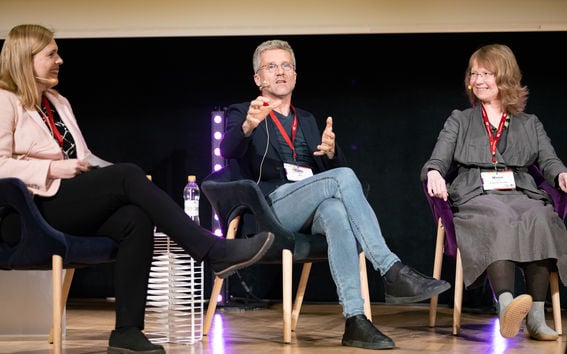How do we make the circular economy a platform?

‘A virtuous cycle is a process or practice strengthened by its results. So how do we make the circular economy a platform that enables virtuous cycles? I would argue this is the fundamental design challenge we are facing,’ says Michael Schrage, a Research Fellow at the MIT Sloan School of Management.
Scrage was speaking at the 2022 MIT-Aalto Symposium, an event that brought thinkers and innovators from around the world together to discuss sustainable innovation in the Nordic context. He explained how ‘platform thinking’ – which is behind the success of companies like Google and Amazon – needs to be brought into the circular economy to enable virtuous cycles for continuous improvement.
Aalto Professor of Hydrometallurgy, Mari Lundström, is working on the circular-economy challenge from the perspective of battery-recycling.
‘Recycling batteries is difficult. They’re metal-intensive products that were never designed for this process – they were designed for performance,' says Lundström. 'As there are multiple chemistries and designs at work in batteries, several different recycling processes are needed to extract the various metals.'
The EU has reacted with battery legislation that is gradually coming into force. The legislation specifies minimum-requirements on recycled contents by 2030, with the amounts rising significantly by 2035. Aalto University has several research initiatives aimed at addressing the legislation.
Spotlight on innovation
Both Aalto and MIT provide support for startups working on sustainable solutions to some of the world’s biggest challenges.
'We believe innovation and sustainability are tightly connected,' says Aalto University President Ilkka Niemelä. ‘Our friends at MIT are very much aligned with us on this view, and we’re looking forward to future cooperation between our two universities.'
One of the most compelling innovations to come out of the MIT Senseable City Lab is The Hot Heart. The winner of the Helsinki Energy Challenge competition, the Hot Heart is a system that converts carbon-free electrical energy into heat. The proposal – which is still in the concept phase – would also create four floating islands covered in tropical forest and with year-round warm pools for Helsinki residents and visitors to enjoy.
Another innovation from MIT is The Copenhagen Wheel, which captures energy while cycling and braking to turn an ordinary bike into an e-bike. Connected sensors provide information on air quality, traffic congestion and more to the cyclist.
Some innovations that grew out of Aalto or MIT are already well on the way to commercialization.
Aalto spinout IQM – which is currently hiring more than one new person every week – says its quantum-computing technology can be used to optimize agriculture for better food harvests. Another Aalto spinout, Nordic Bioproducts Group has created a technology called Aaltocell that enables the creation of cellulose derivatives.
Gradient is a Boston-based cyber-security company with its own AI-driven cognitive library, Amogy has developed a way to create emission-free fuel from ammonia, and Mobilus Labs is using bone-conduction technology to help people in noisy environments communicate more effectively by phone. Leela AI is a machine-learning system that uses video-camera data to create customized insights for industrial applications.
The view from big industry
Established companies have a key role to play in innovation too. Senior managers from Finnish industrial giants Fiskars, Neste, Stora Enso and Wärtsilä also attended the 2022 MIT-Aalto Symposium, sharing their thoughts on the state of corporate innovation in Finland.
In a strong statement of support for collaboration with Aalto University, iconic brand Fiskars has recently moved its corporate headquarters close to Aalto’s main campus.
Wärtsilä President and CEO, Håkan Agnevall, summarised the pros and cons of innovation in the context of traditional Nordic business culture.
‘In Scandinavia we are very good at cooperating across sectors. But everybody knows everybody, and nobody wants to fail in such a small community,’ says Agnevall.
Mika Anttonen, the Founder and Chairman of Finnish energy company St1, says that innovation should now focus on energy-sector transition.
‘Energy consumption is growing at roughly 2% per year, so growth in renewable energy and nuclear should multiply drastically compared to today,’ he says. ‘We need a scientific global roadmap and standardized measurement method. We also need to involve companies in creating a functioning carbon market.’
‘Energy-sector transition is a slow process. We do not have time to waste,’ says Anttonen.
- Published:
- Updated:
Read more news

DeployAI Partners Gather for Heart Beat Meeting in Helsinki
The European DeployAI project's partners gathered for the Heart Beat meeting hosted by Aalto University Executive Education in Helsinki.
HRH Princess Maha Chakri Sirindhorn of Thailand visited Aalto University
During the visit, HRH and her delegation met with Aalto students and explored various activities.
Campus for people, plants and pollinators
The Otaniemi campus nature is managed with respect to biodiversity and the characteristic species of habitats.